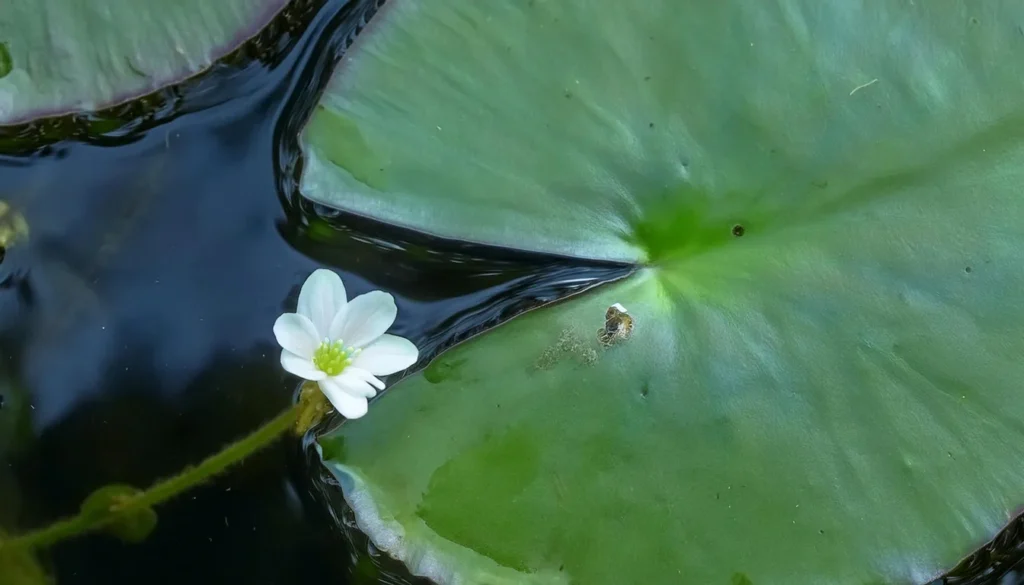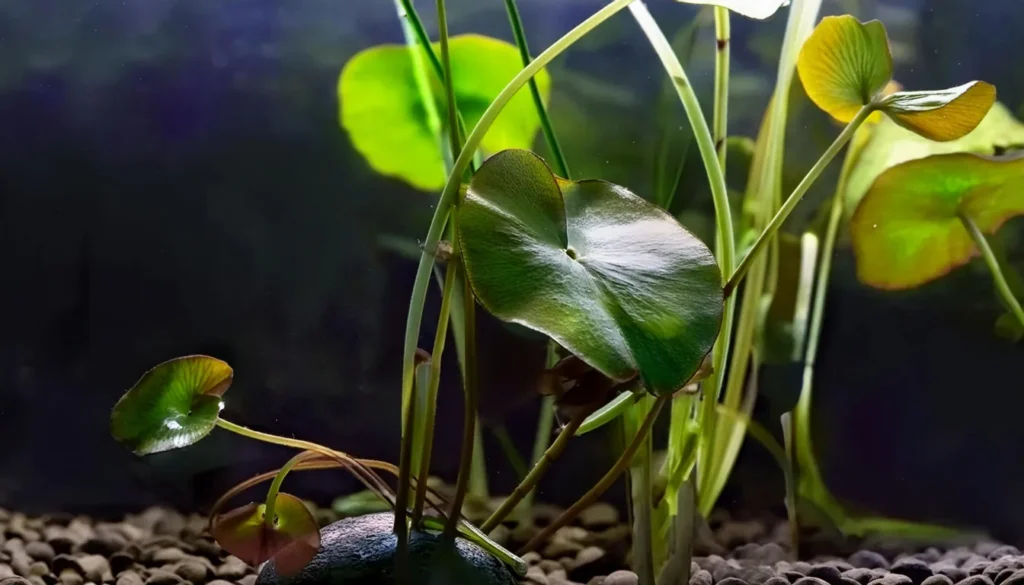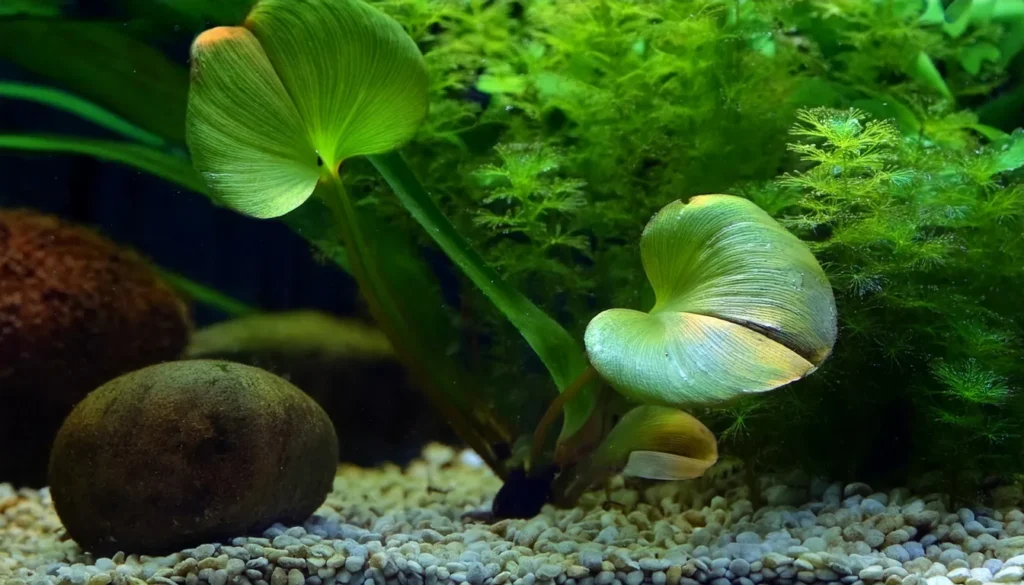Welcome to our comprehensive guide on cultivating and caring for the beautiful Banana Plant, scientifically known as Nymphoides Aquatica.
In this article, we will explore the various aspects of banana plant cultivation and provide expert tips for its care.
Whether you are a beginner or an experienced aquarist, this guide will be valuable in creating a vibrant and thriving aquatic environment in your aquarium.
Key Takeaway
- Learn how to cultivate and care for the stunning Banana Plant, also known as Nymphoides Aquatica.
- Discover the unique characteristics and features of Nymphoides Aquatica.
- Understand the history and origin of the Banana Plant.
- Properly identify Nymphoides Aquatica for successful cultivation.
- Learn about the ideal conditions, including temperature, water quality, and lighting, for the optimal growth of the Banana Plant.
Quick Stats
| Attribute | Details |
| Family Name | Menyanthaceae |
| Origin | Southeastern United States |
| Height | Leaves float on the surface; tubers stay at the bottom |
| pH Range | 6.0 – 7.5 |
| CO2 Requirement | Low |
| Growth Rate | Slow to Moderate |
| Care Level | Easy |
| Color Form | Green leaves with banana-shaped tubers at the base |
| Water Conditions | 20-26°C (68-79°F), adaptable to a range of water hardness |
| Max Size | Leaves can spread 15-20 cm (6-8 inches) across the water surface |
| Lighting | Low to Moderate |
| Supplements | Minimal; benefits from a nutrient-rich substrate |
| Placement | Mid-ground to Background; tubers buried with leaves floating or near the surface |
| Propagation | Occasionally produces daughter plants from the base of the leaves |

What Is Nymphoides Aquatica?
Nymphoides Aquatica, commonly referred to as the Banana Plant, is an aquatic plant that is native to parts of North America, Europe, and Asia.
It is known for its beautiful and distinctive appearance, with long oval-shaped leaves and yellow-orange flowers.
The plant has both terrestrial and aquatic adaptations, making it a versatile choice for aquarium enthusiasts.
In this section, we will delve into the unique characteristics and features of Nymphoides Aquatica.
History And Origin
The history and origin of Nymphoides Aquatica, or the Banana Plant, can be traced back to its natural habitats in wetlands, marshes, and sunny areas of rivers, lakes, and ponds.
This aquatic plant has captivated enthusiasts with its beauty for many years.
Understanding the history and origin of the Banana Plant provides valuable insights into its natural adaptations and how it has become a popular choice among aquarium enthusiasts.
Let’s dive deeper into the fascinating aquatic plant history.
The Banana Plant has a rich history spanning different regions of North America, Europe, and Asia.
It was first discovered in the wild, where it thrived in the lush wetlands and marshes, adapting to both terrestrial and aquatic environments.
Over time, the Banana Plant caught the attention of plant lovers and aquarium hobbyists who were drawn to its striking appearance.
Its long, oval-shaped leaves and vibrant yellow-orange flowers added a unique touch of beauty to any aquatic setting.
As a result, the Banana Plant was cultivated and introduced into the aquarium trade.
Today, with its fascinating history and origins, the Banana Plant has become a beloved choice for aquarists worldwide.
Its natural adaptations and aesthetic appeal continue to make it a timeless classic in the world of aquatic plants.

Physical Characteristics
- Leaf Structure: Its leaves are round to oval-shaped, resembling the shape of a banana, hence the name “Banana Plant.” The leaves often have a slightly crinkled or ruffled appearance along the edges.
- Coloration: The leaves typically range from green to reddish-brown, depending on factors such as light intensity and nutrient availability. In some cases, the undersides of the leaves may have a purplish hue.
- Size: Nymphoides aquatica can vary in size, with individual leaves growing to lengths of around 2 to 5 inches (5 to 13 centimeters). The plant itself can reach heights of up to 8 to 12 inches (20 to 30 centimeters) under optimal conditions.
- Root System: Beneath the substrate, Banana Plants develop a network of thin, fibrous roots that anchor the plant in place and absorb nutrients from the water column.
- Rhizome Structure: Like many aquatic plants, Nymphoides aquatica grows from a rhizome, which is a horizontal stem that produces roots and shoots. The rhizome may appear as a thick, knobby structure from which new leaves and roots emerge.
- Flowering: Under suitable conditions, Banana Plants may produce small, white or yellow flowers that emerge above the water’s surface. These flowers add to the plant’s aesthetic appeal and can attract pollinators.
- Growth Habit: Nymphoides aquatica is a relatively slow-growing plant, especially compared to some other aquatic species. It tends to spread laterally via its rhizome, gradually forming dense clusters of foliage.
Plant Lighting Requirements
- Proper lighting is essential for the photosynthesis process and overall growth of Nymphoides Aquatica. It is recommended to provide moderate to high-intensity lighting in the range of 2 to 3 watts per gallon. This will enable the plant to efficiently convert light energy into vital nutrients.
- Using a full-spectrum LED or fluorescent light fixture, with a color temperature between 5000K to 7000K, will provide the necessary light spectrum for Nymphoides Aquatica’s photosynthesis process.
- It is important to ensure a consistent light period of 10 to 12 hours daily. Using a timer for your aquarium lights will help maintain a regular lighting schedule, promoting healthy growth and replicating the natural light cycle.

Temperature And Water Quality
- To ensure the healthy growth of Nymphoides Aquatica, it is important to maintain the ideal temperature range and water quality in your aquarium. The recommended temperature for this aquatic plant is between 72°F to 82°F (22°C to 28°C).
- Water quality plays a vital role in Nymphoides Aquatica’s well-being. It is important to keep the water clean and free from toxins. Regular water testing and maintenance will help ensure that the nutrient levels are balanced and the pH level is within the optimal range of 6.5 to 7.5.
- Implementing proper filtration and a regular water change schedule will help maintain optimal water quality, providing a healthy environment for the Banana Plant to thrive.
Choosing The Right Substrate
- Particle Size: Opt for a substrate with a fine to medium particle size, allowing for proper root development and preventing compaction.
- Nutrient Content: Choose a substrate that is rich in nutrients to support healthy plant growth. Look for substrates specifically designed for aquatic plants.
- Capping Layer: Consider adding a capping layer to the substrate to prevent nutrient leaching and ensure long-lasting fertility.
Placement Option
- Foreground or Midground: Planting Banana Plants towards the front or middle of the aquarium or pond allows them to be prominently featured in the aquascape. Their relatively low height makes them suitable for these positions without obstructing the view of other plants or decor elements.
- Along the Edge: Banana Plants can be strategically placed along the edges of the aquarium or pond, where they can cascade over the substrate and create a natural border. This placement adds visual interest and softens the transition between the aquatic environment and surrounding decor.
- Near Hardscape Features: Placing Banana Plants near rocks, driftwood, or other hardscape features can enhance the overall aesthetic appeal of the aquascape. The contrast between the soft, rounded leaves of the plants and the rugged texture of the hardscape creates a visually appealing contrast.
- Under Floating Plants: If your aquarium or pond features floating plants such as Water Lettuce or Water Hyacinth, consider placing Banana Plants beneath them. This provides shaded areas for the Banana Plants and creates a dynamic, multi-layered look in the aquatic environment.

Recommended Tank Size
The recommended tank size for Nymphoides aquatica, also known as Banana Plant or Banana Lily, depends on various factors including the number of plants, the size of the aquarium, and the desired aquascape.
However, as a general guideline:
- For a single Banana Plant, a tank with a capacity of at least 10 gallons (38 liters) is suitable.
- If planting multiple Banana Plants or incorporating them into a larger aquascape, a tank of 20 gallons (75 liters) or more would be preferable.
Suitable Tank Mates
- Nymphoides aquatica, or Banana Plant, can coexist well with a variety of fish and invertebrates commonly kept in freshwater aquariums. Suitable tank mates include peaceful community fish such as tetras, rasboras, guppies, and dwarf gouramis.
- Shrimp species like Cherry Shrimp and Amano Shrimp can also thrive alongside Banana Plants. However, it’s important to avoid aggressive or large species that may uproot or damage the delicate roots and leaves of the plant. Always research the specific needs and behaviors of potential tank mates to ensure compatibility with Nymphoides aquatica.
Nutritional Needs Of The Plant
- Lighting: Nymphoides aquatica thrives under moderate to high lighting conditions, as it requires sufficient light for photosynthesis to occur effectively. Adequate lighting supports healthy leaf growth and vibrant coloration. Providing LED lights or fluorescent tubes with adjustable intensity can help tailor the lighting to the plant’s needs.
- Water Parameters: Maintaining stable water parameters is crucial for the health of Nymphoides aquatica. The ideal temperature range is between 72-82°F (22-28°C), while the pH should be maintained around 6.5-7.5. Additionally, ensure moderate water hardness to support optimal plant growth and development. Regular monitoring and adjustment of these parameters are necessary to create a stable aquatic environment.
- Substrate: A nutrient-rich substrate is essential for Nymphoides aquatica to establish strong roots and absorb essential nutrients. Use a substrate specifically designed for planted aquariums or incorporate root tabs to provide essential nutrients like iron, potassium, and trace elements. A nutrient-rich substrate encourages robust growth and vibrant foliage.
- Fertilization: Supplementing with a balanced aquarium fertilizer ensures that Nymphoides aquatica receives all the necessary nutrients for healthy growth. Choose a liquid fertilizer formulated for aquatic plants and dose according to the manufacturer’s instructions. Regular fertilization helps prevent nutrient deficiencies and promotes lush, vigorous growth.

Nymphoides Aquatica Cultivation Tips
- Lighting: Provide moderate to high lighting conditions to support healthy growth. LED lights or fluorescent tubes with adjustable intensity are suitable options. Aim for a lighting duration of 8-10 hours per day to mimic natural daylight cycles.
- Water Parameters: Maintain stable water parameters within the following ranges: temperature between 72-82°F (22-28°C), pH around 6.5-7.5, and moderate water hardness. Regular water changes help prevent the buildup of toxins and maintain water quality.
- Substrate: Use a nutrient-rich substrate or incorporate root tabs to provide essential nutrients for root development. A mixture of gravel and aquatic soil works well. Ensure the substrate is deep enough to accommodate the plant’s root system.
- Fertilization: Supplement with a liquid fertilizer specifically formulated for aquarium plants to ensure adequate nutrient levels. Pay attention to the iron content, as Nymphoides aquatica benefits from iron supplementation for vibrant growth and coloration.
- Carbon Dioxide (CO2): While not mandatory, providing CO2 supplementation can enhance growth. Consider using a CO2 injection system, especially in high-tech planted aquarium setups, to promote robust growth and vibrant foliage.
RELATED: Exploring The Beauty Of Lysimachia Nummularia Green

Plant Propagation Tips
- Division: Nymphoides aquatica can be propagated through division. When the plant has grown sufficiently, carefully separate the rhizome into smaller sections, ensuring each section has healthy roots and shoots. Use sharp, clean scissors or a knife to avoid damaging the plant tissue.
- Separating Runners: Nymphoides aquatica produces runners that can be separated from the parent plant and replanted to propagate new individuals. Wait until the runners have developed their own root systems before detaching them from the parent plant. Gently separate the runner from the parent plant and plant it in the substrate.
- Planting Runners: When planting the separated runners, ensure they are planted in a suitable location in the substrate with enough space for root growth. Press the base of the runner into the substrate and cover it lightly with substrate to secure it in place.
- Optimal Conditions: Provide optimal growing conditions for newly propagated plants, including adequate lighting, nutrient-rich substrate, and stable water parameters. Ensure sufficient water flow to prevent stagnant conditions around the newly planted sections.
The Rewarding Benefits Of Planting A Banana Plant
- Aesthetic Value: The Banana Plant adds a touch of natural beauty to your aquarium with its long oval-shaped leaves and vibrant yellow-orange flowers. Its unique appearance creates a visually striking underwater landscape, enhancing the overall aesthetic appeal of your tank.
- Oxygenation: One of the banana plant’s important benefits is its ability to oxygenate the water. Through photosynthesis, it releases oxygen into the aquarium, promoting a healthy environment for fish and other aquatic organisms. Improved oxygen levels contribute to the overall well-being of the tank’s inhabitants.
- Water Quality Improvement: The presence of the Banana Plant in your aquarium can help improve water quality. It absorbs excess nutrients, such as nitrates and phosphates, which are byproducts of fish waste and uneaten food. By reducing these harmful substances, the plant contributes to a balanced ecosystem and prevents algae growth.

Conclusion
Cultivating and caring for Nymphoides Aquatica, or the Banana Plant, can be a rewarding experience for aquarium enthusiasts of all levels.
By following the guidelines and tips discussed in this comprehensive guide, you can create a thriving and visually stunning aquatic environment in your tank.
Whether you are captivated by the banana plant’s unique appearance or its ecological benefits, it is a fantastic choice for anyone looking to enhance their aquarium.
Its long, oval-shaped leaves and yellow-orange flowers add beauty and vibrancy to any tank.
Additionally, this plant contributes to oxygenation and improves water quality, creating a natural and vibrant underwater habitat.
Now armed with the knowledge of Nymphoides Aquatica cultivation and care, you can confidently incorporate this plant into your aquarium.
From ensuring the ideal growing conditions, integrating it into your tank’s design, and managing its growth to proper maintenance and propagation, we have covered all the essential aspects of cultivating and caring for this fascinating aquatic plant.
Frequently Asked Questions
How Do I Integrate Nymphoides Aquatica Into My Tank?
Integrating Nymphoides Aquatica into your tank involves choosing the right substrate for proper root anchoring and nutrient absorption.
Additionally, selecting an appropriate aquascaping style will enhance your tank’s visual appeal and accommodate the Banana Plant’s growth requirements.
How Can I Manage The Growth Of Nymphoides Aquatica?
To manage Nymphoides Aquatica’s growth, you can employ strategies such as regular pruning and preventing it from dominating your aquarium.
It’s also important to identify and address common pests and diseases that may affect the plant.
What Are The Propagation Techniques For Banana Plants?
Nymphoides Aquatica can be propagated through vegetative reproduction and seeding tactics.
These methods allow you to expand your collection of Banana Plants and create a lush and thriving aquarium.
How Do I Maintain Nymphoides Aquatica?
Regular maintenance of Nymphoides Aquatica involves proper pruning strategies to control the plant’s size and promote new growth.
Additionally, attention to water parameters, nutrient supplementation, and overall tank conditions is essential for the long-term health of the plant.
What Are The Rewarding Benefits Of Planting A Banana Plant?
Planting a Banana Plant in your aquarium offers benefits such as oxygenation of the water, improvement of water quality, and the creation of a natural and vibrant underwater habitat.
- Unveiling The Wonders Of Riccia Fluitans In Aquascapes - August 7, 2024
- Vallisneria Gigantea Var. Guide To Care And Cultivation At Home - July 31, 2024
- Vesicularia Dubyana Care & Growth Guide Tips For Beginner Gardeners - July 30, 2024
